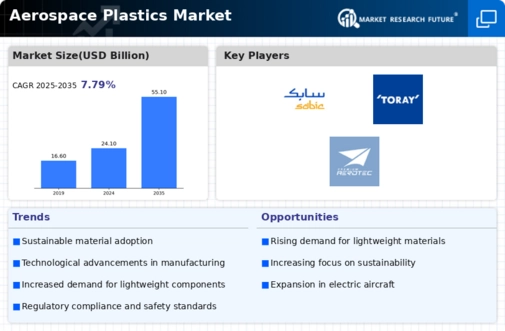Market Trends
Key Emerging Trends in the Aerospace Plastics Market
The Aerospace Plastics Market is currently undergoing notable trends that are reshaping the industry across various applications. One significant trend is the increasing demand for lightweight and high-performance plastics in the aerospace sector. With a continual emphasis on fuel efficiency, reduced emissions, and enhanced performance, aerospace manufacturers are increasingly incorporating advanced plastics in the design and production of aircraft components. This trend is driven by the need to achieve weight savings, improve fuel economy, and meet stringent regulatory standards in the aviation industry.
Environmental sustainability is emerging as a key driver influencing market trends in the Aerospace Plastics Market. As the aerospace industry faces increasing scrutiny regarding its environmental impact, there is a growing shift towards the use of eco-friendly and recyclable plastics. Manufacturers are investing in research and development to develop aerospace plastics with improved sustainability profiles, addressing concerns about material waste and end-of-life disposal. This trend aligns with the broader global push for green and sustainable practices in manufacturing.
Technological advancements play a pivotal role in shaping market trends in the Aerospace Plastics Market. Ongoing research efforts focus on enhancing the properties and performance of aerospace plastics, including improvements in strength, heat resistance, and flame retardancy. Innovations in polymer formulations, processing techniques, and additive manufacturing contribute to the development of plastics that can withstand the demanding conditions of aerospace applications. These technological trends cater to the aerospace industry's need for materials that provide both structural integrity and design flexibility.
The commercial aviation sector is another significant influencer of market trends in the Aerospace Plastics Market. As airlines seek to reduce operating costs and improve fuel efficiency, the adoption of plastics in aircraft interiors and structural components is on the rise. Plastics offer the advantage of being lighter than traditional materials like metal, contributing to overall weight reduction and fuel savings. This trend is further accelerated by the increasing demand for air travel, prompting the aerospace industry to explore innovative materials that enhance aircraft performance.
Supply chain dynamics and raw material costs are critical factors impacting market trends in the Aerospace Plastics Market. The availability and pricing of raw materials, such as high-performance polymers and composites, can influence the overall cost of aerospace plastics. Fluctuations in raw material prices, geopolitical factors affecting the supply chain, and global economic conditions can pose challenges for manufacturers. Companies in the Aerospace Plastics Market are actively managing their supply chains, exploring alternative materials, and adopting strategies to ensure a stable and cost-effective production process.
Moreover, there is a growing trend towards the development of flame-retardant and self-extinguishing aerospace plastics. As safety remains a top priority in aviation, the industry is increasingly focusing on materials that comply with stringent fire safety regulations. Aerospace plastics with enhanced flame-retardant properties are gaining traction for use in critical applications, such as interior components and structural elements, contributing to improved passenger safety and overall aircraft integrity. This trend reflects the industry's commitment to meeting the highest safety standards in aviation.






Leave a Comment